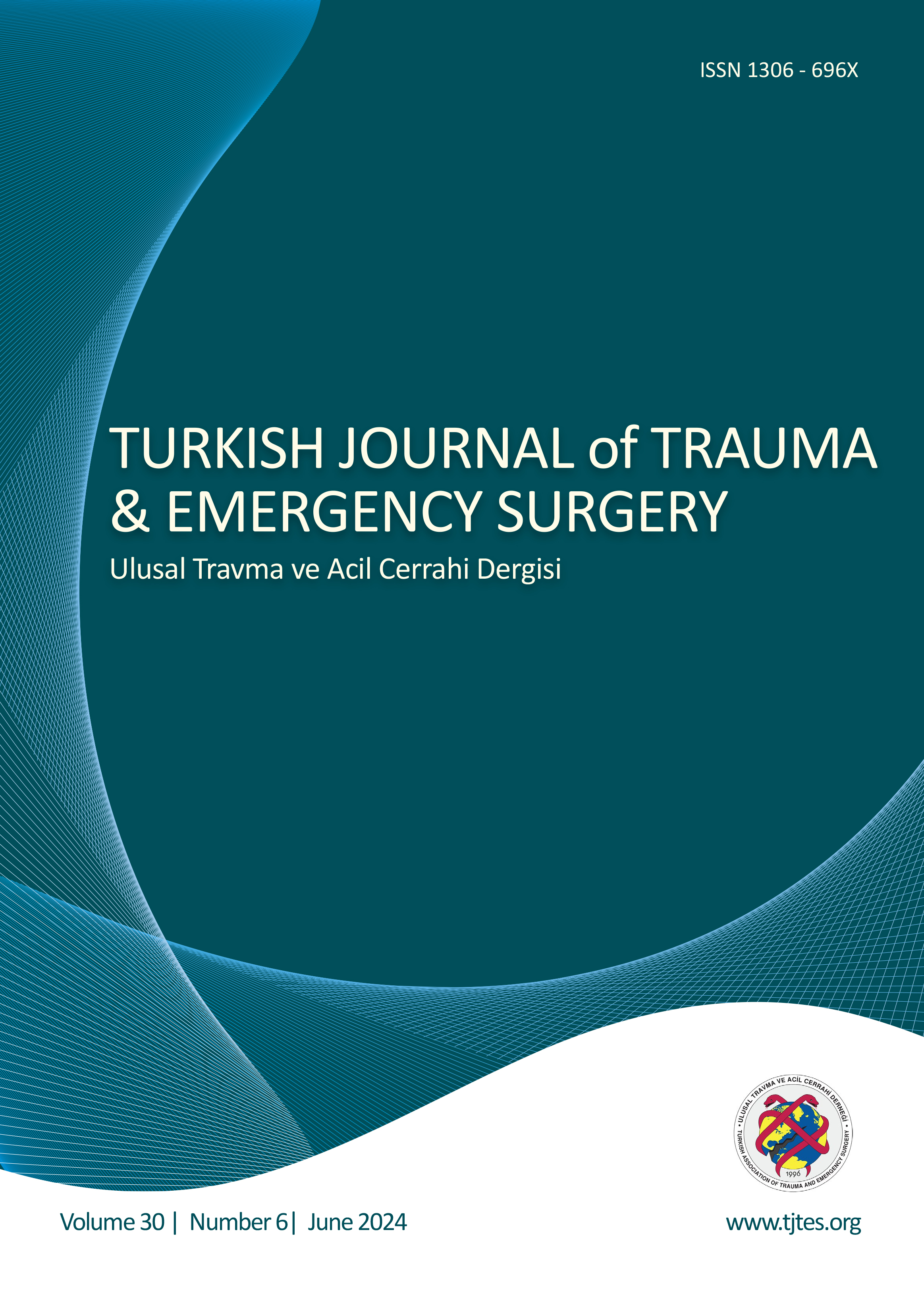Quick Search
Effects of lupeol on experimental testicular ischemiareperfusion damage in rats
Abdurrahman Azzam1, Ramazan Karabulut1, Cem Kaya1, Sibel Eryılmaz1, Alparslan Kapisiz1, Zafer Turkyilmaz1, Mehmet Arda Inan2, Gizem Yaz Aydin3, Ali Atan4, Kaan Sonmez11Department of Pediatric Surgery, Gazi University Faculty of Medicine, Ankara, Türkiye2Department of Pathology, Gazi University Faculty of Medicine, Ankara, Türkiye
3Department of Biochemistry, Gazi University Faculty of Medicine, Ankara, Türkiye
4Department of Urology, Gazi University Faculty of Medicine, Ankara, Türkiye
Background: Infertility and organ loss are possible outcomes of testicular torsion, a urological emergency. This study aimed to demonstrate the impact of lupeol on testicular ischemia/reperfusion damage.
Methods: Thirty adult male SpraqueDawley rats were randomized into five groups: Control (C), Lupeol (L), Ischemia (Isc), Treatment 1 (T1), and Treatment 2 (T2). In the study groups, detorsion was applied to the left testicles by creating a 720-degree testicular torsion for 2 h. Additionally, in the T1 and T2 groups, 100 mg/kg of lupeol was injected intraperitoneally 30 minutes before and immediately after detorsion. At the sixth hour,aBACKGROUND: Infertility and organ loss are potential consequences of testicular torsion, a urological emergency. This study aimed
to evaluate the impact of lupeol on testicular ischemia-reperfusion damage.
METHODS: Thirty adult male Sprague-Dawley rats were randomly assigned to five groups: Control (C), Lupeol (L), Ischemia (Isc),Treatment 1 (T1), and Treatment 2 (T2). In the study groups, detorsion was applied to the left testicles following the induction of 720-degree testicular torsion for two hours. In the T1 and T2 groups, 100 mg/kg of lupeol was administered intraperitoneally 30 minutes before and immediately after detorsion. At the sixth hour, blood and testicular tissue samples were collected from each rat. Measurements included serum interleukin-6 (IL-6) and tumor necrosis factor-α (TNF-α), tissue glutathione (GSH), malondialdehyde (MDA), and caspase-3 levels. Histopathological analysis was performed to assess the Johnsen Tubular Biopsy Score (JTBS).
RESULTS: Levels of caspase-3 (2.74±0.32), MDA (1.71±0.26), IL-6 (4.92±0.57), and TNF-α (113.18±29.77) were elevated in Group Isc compared to Group C and showed a significant reduction in Group T2 (2±0.67, 1.16±0.36, 3.95±0.17, and 106.13±12.49, respectively) and particularly in Group T1 (1.65±0.50, 0.95±0.143, 80±0.35, and 104.86±8.42, respectively) (p=0.001). However, while TNF-αlevels decreased in both treatment groups, the difference was not statistically significant (p=0.768). GSH levels decreased in Group Isc(140.63±25.71) but increased in Group T2 (211.58±95.05) (p=0.753) and particularly in Group T1 (219.9±48.21)(p=0.078). The JTBS
was lowest in Group Isc (7.67±0.25). However, improvements were observed in both treatment groups (8.93±0.16 and 8.82±0.22, respectively) (p=0.001).
CONCLUSION: This study, the first to use lupeol in an experimental testicular torsion model, demonstrated its antioxidant, antiinflammatory, anti-apoptotic, histopathological damage-reducing, and protective effects. blood and testicular tissue samples were obtained from each rat. Serum interleukin-6 (IL-6) and tumor necrosis factor-α (TNF-α), tissue glutathione (GSH), malondialdehyde (MDA), and caspase-3 measurements were also obtained. Histopathological analysis was used to evaluate the Johnsen Tubular Biopsy Score (JTBS).
Results: Caspase-3 (2,74±0,32), MDA (1,71±0,26), IL-6 (4,92±0,57), and TNF-ɑ (113,18±29,77) values increased in Group Isc compared to Group C and significantly decreased in T2 (2±0,67, 1,16±0,36, 3,95±0,17, and 106,13±12,49) and particularly T1 groups (1,65±0,50, 0,95±0,143, 80±0,35, and 104,86±8,42) (p=0.001). However, TNF-α levels decreased in both treatment groups, with no statistically significant difference (p=0.768). GSH levels decreased in Group Isc (140,63±25,71) but increased in T2 (211,58±95,05) (p=0.753) and particularly in T1 groups (219,9±48,21) (p=0.078). JTBS was lowest in Group Isc (7,67±0,25). Improvement was observed in both treatment groups (8,93±0,16 and 8,82±0,22) (p=0.001).
Conclusion: This study, which is the first to use lupeol in an experimental testicular torsion model, demonstrated its antioxidant, anti-inflammatory, antiapoptotic, and histopathological damage-reducing and protective effects.
Lupeol'ün sıçanlarda deneysel testiküler iskemi/reperfüzyon hasarı üzerine etkileri
Abdurrahman Azzam1, Ramazan Karabulut1, Cem Kaya1, Sibel Eryılmaz1, Alparslan Kapisiz1, Zafer Turkyilmaz1, Mehmet Arda Inan2, Gizem Yaz Aydin3, Ali Atan4, Kaan Sonmez11Gazi Üniversitesi Tıp Fakültesi, Çocuk Cerrahisi Anabilim Dalı, Ankara, Türkiye2Gazi Üniversitesi Tıp Fakültesi, Patoloji Anabilim Dalı, Ankara, Türkiye
3Gazi Üniversitesi Tıp Fakültesi, Biyokimya Anabilim Dalı, Ankara, Türkiye
4Gazi Üniversitesi Tıp Fakültesi, Üroloji Anabilim Dalı, Ankara, Türkiye
AMAÇ: Kısırlık ve organ kaybı, ürolojik acil durum olan testis torsiyonunun olası sonuçlarıdır. Bu araştırmada lupeolün testiküler iskemi reperfüzyon hasarı üzerindeki etkisini göstermeye çalıştık.
GEREÇ VE YÖNTEM: 30 adet yetişkin erkek Spraque Dawley sıçanı randomize edilerek Kontrol(C), Lupeol(L), İskemi(I), Tedavi 1(T1) ve Tedavi 2(T2) gruplarına ayrıldı. Çalışma gruplarında sol testislere 2 saat boyunca 720 derece testis torsiyonu oluşturularak detorsiyon uygulandı. T1 ve T2 gruplarına detorsiyondan 30 dakika önce ve hemen sonra 100 mg/kg Lupeol intraperitoneal olarak enjekte edildi. Altıncı saatte her sıçandan kan
ve testis dokusu örnekleri alındı. Serum interlökin-6(IL-6) ve tümör nekroz faktörü-α (TNF-α), doku glutatyonu (GSH), malondialdehit (MDA) ve kaspaz 3 ölçümleri için kan alındı. Johnsen Tübüler Biyopsi Skorunu (JTBS) değerlendirmek için histopatolojik analiz yapıldı.
BULGULAR: Kaspaz 3 (2.74±0.32), MDA (1.71±0.26), IL-6 (4.92±0.57) ve TNF-α (113.18±29.77) değerleri Grup I'de Grup C'ye göre artarken T2'de (2±0.67, 1.16±0.36, 3.95±0.17 ve 106.13±12.49) ve özellikle T1 grubunda (1.65±0.50, 0.95±0.143, 80±0.35 ve 104.86±8.42) belirgin azalma saptandı (p=0.001). Ancak istatistiksel olarak anlamlı bir fark olmamasına rağmen her iki tedavi grubunda da TNF-α'da azalma vardı (p=0.768). GSH düzeyleri Grup I'de azalırken (140.63±25.71), T2 grubunda (211.58±95.05) (p=0.753) ve özellikle T1 grubunda (219.9±48.21) artma gözlendi
(p=0.078). JTBS en düşük skoru Grup I'de görülürken (7.67±0.25), tedavi gruplarında iyileşme gözlendi (8.93±0.16 ve 8.82±0.22), (p=0.001).
SONUÇ: Lupeol'ün ilk kez deneysel testis torsiyon modelinde kullanıldığı bu çalışmada antioksidan, antienflamatuvar ve antiapoptotik etkilerinin yanı sıra histopatolojik hasarı azaltıcı ve koruyucu etkileri de ortaya konmuştur.
Manuscript Language: English




